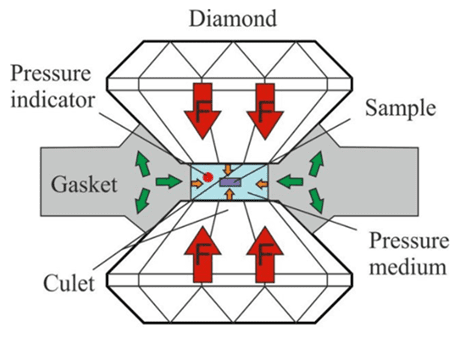Generalities on Diamond Anvil Cells (DACs)

If I am new to the world of high pressure, where should I start and what do I need? Is a question often used by researchers who wants to get started in this fascinating field. This resource is meant to provide some pointers and is by no means meant to cover the topic in depth.

Figure 1: Cross section of the region where the experiment takes place inside a DAC
What is a Diamond Anvil Cell (DAC)?
The diamond anvil cell is a versatile tool used to study materials under extreme conditions of pressure usually in the GPa pressure range. The central part is made of two inverted diamond anvils with a metallic gasket sandwiched in between. In the middle of this gasket is a tiny hole which acts as the sample space. In order to increase the pressure on the sample, one needs to apply some force on these two diamonds and it can be done in different ways depending on the geometry and structure (two plates or piston-cylinder typically). Thus, the high force applied to the large side of the diamonds (table) generates high pressure at the small tip of the two anvils (culet).
Diamond properties makes it the ideal anvil material for in-situ high pressure experiments:
· Transparency across a wide range of electromagnetic radiations
· Chemically inert
· Extreme hardness
What is the sample size relative to the targeted pressure?
There is a key point to remember in high pressure experiments: “the higher the pressure, the smaller the sample”. Table 1 below shows examples of sample chamber size relative to the diamond culet size and the targeted maximum pressure,
| Culet Size (mm) | Max. Pressure (GPa) | Sample Chamber dia. (um) | Sample Chamber thickness (um) |
|---|---|---|---|
| 1.00 | 10 | 350 | 150 |
| 0.60 | 28 | 200 | 100 |
| 0.30 | 74 | 100 | 50 |
| 0.10 | 150 | 35 | 15 |
| 0.03 | >250 | 10 | 5 |
What are the different types of DAC available?
The force generated by DACs can be produced by different mechanisms. Most of the DACs are screw-driven or membrane-driven (Figure 2a and 2b respectively). But there are also other ways to generate the force: by a lever arm design, with the turnbuckle principle or by bending the DAC plates using a gearbox (Figure 2c, 2d and 2e respectively).

Figure 2: Overview of different DAC designs by Almax easyLab.
Discover our products with the links below
(a) SymmDAC (screw driven), (b) OmniDAC (membrane driven), (c) LeverDAC Maxi (lever arm design), (d) TozerDAC (turnbuckle principle) and (e) PlateDAC (bending plates, gearbox driven).
What is needed to prepare an experiment with a DAC?
· A good stereomicroscope to align the cell and to mount the sample.
· Pressure transmitting medium (ethanol and methanol for example)
· Ruby powder as a pressure indicator (if pressure is measured optically)
· Method to drill the gasket where the sample will be loaded. Almax easyLab also supplies Boehler Microdriller in order to drill the sample chamber inside gaskets (Figure 3a and 3b)
· Method to measure the ruby fluorescence (if pressure is measured optically). Almax easyLab also supplies different optical systems for measuring pressure (Figure 3c and 3d).

Figure 3: Boehler Microdriller from Almax easyLab, used to prepare sample chamber inside gaskets (a). Zoom in of the drilling plateform (b). Optical systems from Almax easyLab, used to measure Ruby fluorescence for pressure determination: OptiPrexx PLS (c) and RubyLUX (d).
Discover our RubyLine Range of products for pressure measurements.
The Boehler uDriller gives you a convenient solution to prepare your sample space.
What measurements can be done with a DAC?
· The sample may be viewed at pressure and temperature using an optical microscope.
· Temperature may be high (resistive or laser heating) or low (in cryostat).
· Lasers, of various wavelengths, may be used to measure optical Raman, Brillouin, or IR spectra.
· X-rays may be used to measure nuclear resonance scattering and diffraction from both single and polycrystals.
· Magnetic properties may also be measured as well as sound speed.
Transport measurements may be measured when using electrical leads
Conclusion
DACs allow a wide range of possibilities for high pressure research. Nowadays, much of what is known about the physical properties of materials at pressures above 26 GPa comes from DAC experiments.
For more specific information about your requirements, do not hesitate to contact us at sales@almax-easyLab.com
Dr Christophe GUILLAUME (Application Scientist at Almax easyLab)

